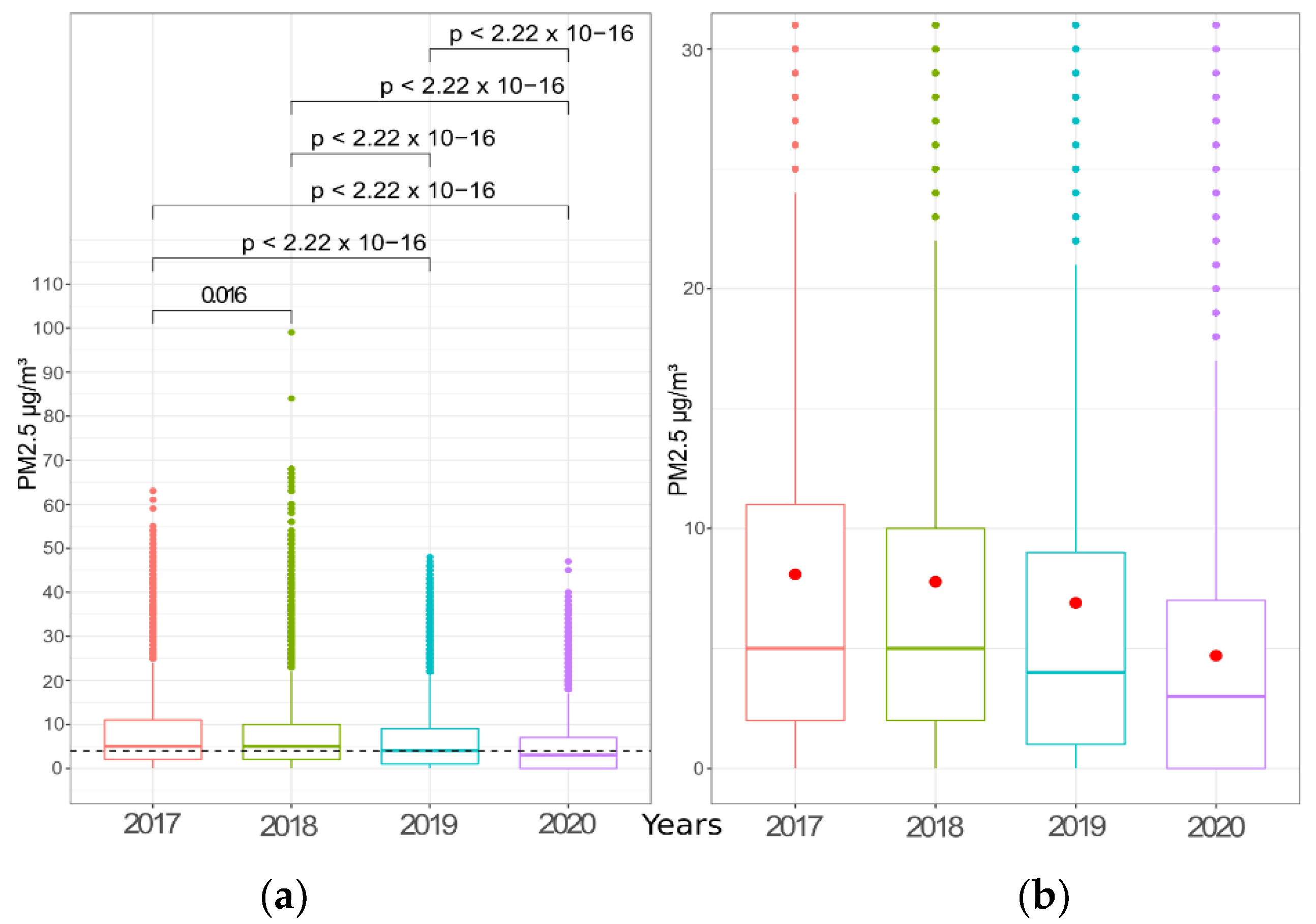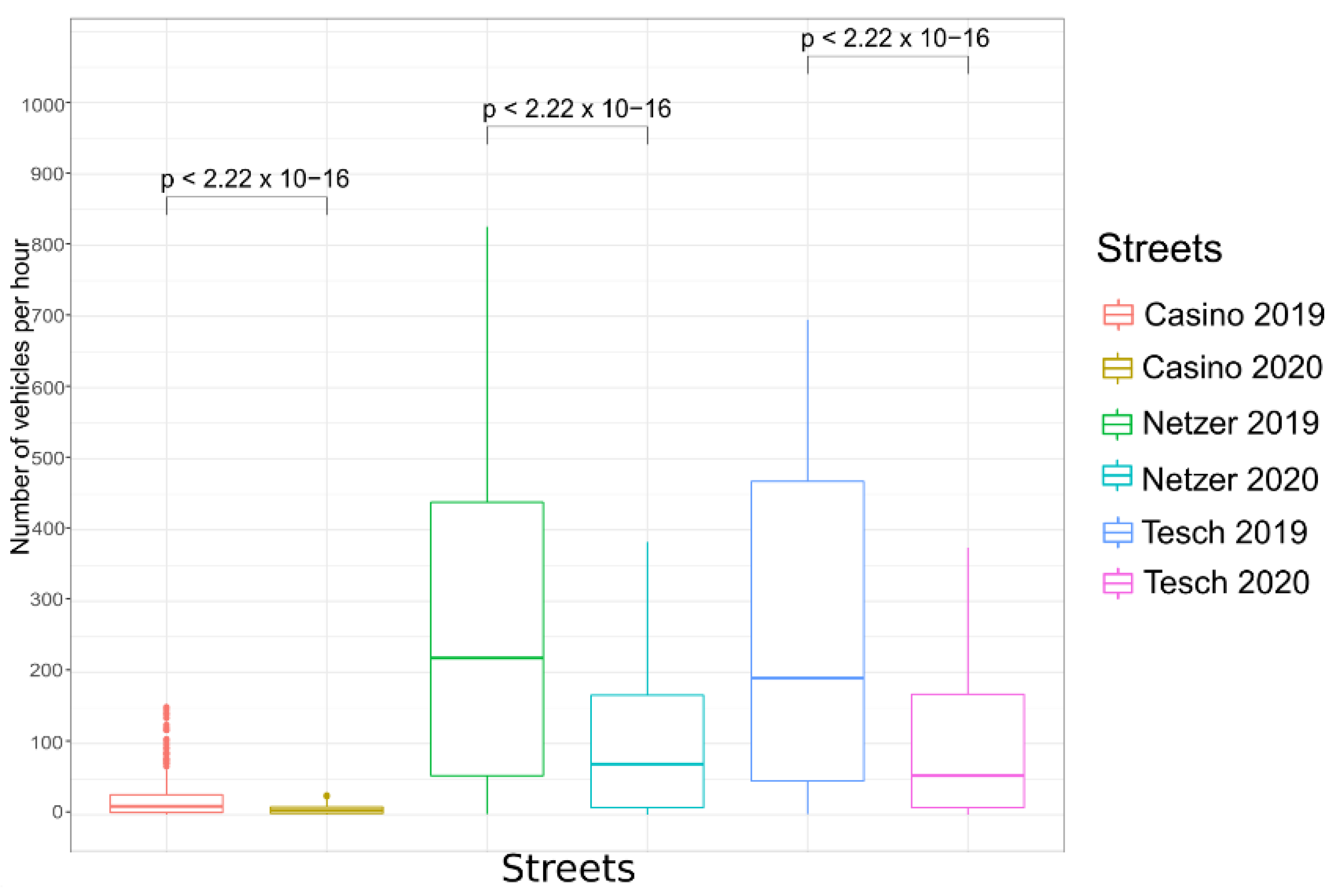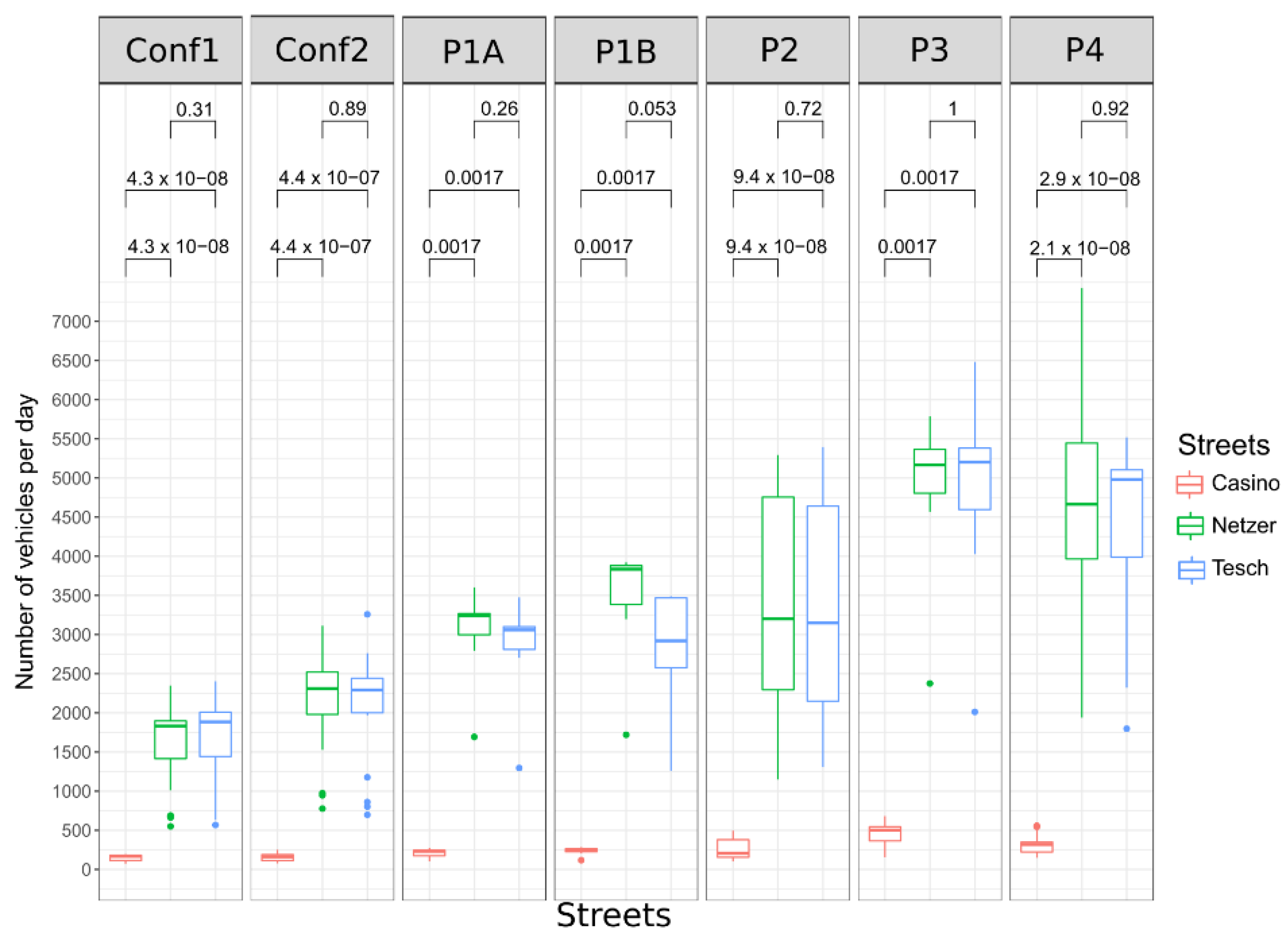Influence of the Lockdown on PM2.5 Concentrations around an Urban School in the South of Belgium
Abstract
:1. Introduction
2. Materials and Methods
2.1. Sampling Site
- Rue Joseph Netzer (hereafter “Netzer”) is a one-way street in front of the main entrance to the secondary school section: altitude 411 m;
- Rue du Casino, (hereafter “Casino”) is a one-way street in front of the main entrance to the primary school section. The street rises 8.7% southeast to northwest;
- Avenue Victor Tesch, (hereafter “Tesch”) is two-way street in front of the second entrance of the secondary school section: altitude 400 m.
2.2. Material
2.2.1. PM2.5 Monitoring––Low-Cost Sensors
- The median of the three sensors was calculated for each time step;
- If a sensor value differed by 15 µg/m3 (median less than 100 µg/m3) or 15% (median greater than 100 µg/m3), the value was rejected as likely being due to sensor fouling. Otherwise, the three values were conserved.
2.2.2. Traffic Monitoring
2.2.3. PM2.5––Reference Monitoring Station
2.3. Measurement Campaign
- Conf1: (17 March to 14 April 2020) lockdown;
- Conf2: (15 April to 03 May 2020) reopening of the DIY shops and resumption of building work;
- P1A: (4 May to 10 May 2020) reopening of industries;
- P1B: (11 May to 17 May 2020) reopening of shops;
- P2: (18 May to 7 June 2020) reopening of museums and zoos, resumption of outdoor sports (club), authorization to see each other in private, reopening of schools but only for students in the final cycle (primary and secondary);
- P3: (8 June to 14 June 2020) personal bubble increased to 10 people, reopening of hotels, restaurants, and catering (HoReCa) sectors, resumption of indoor sports;
- P4: (from 15 June) reopening of borders.
2.4. Data Treatment
3. Results and Discussion
3.1. Background PM2.5 Concentrations—Time Evolution
3.2. Weather Conditions—Before, during, and after the Lockdown
- Before lockdown: winds were predominantly from the southwest with a higher average wind speed than in previous years. Precipitation was heavier and more frequent. These meteorological conditions were largely favorable to good air quality, which explains the differences in PM2.5 concentrations compared with previous years [20].
- During lockdown: the weather was dry, sunny with continental currents (ENE), which were not favorable to good air quality, especially in the spring when particulate matter peaks are more frequent, particularly due to agricultural activity [20]. However, the PM2.5 concentrations at the Habay station were lower than for previous years. One explanation could be the reduction of human activity like driving. Another explanation could be that the wind direction did not transport ambient air from the highway (source of PM2.5) to the measurement station (Figure 2, highway E25/E411). Despite this observation, there were some peaks of concentration. Indeed, an ENE wind could have transported PM from agricultural areas, the village of Habay-la-Neuve, or forests (pollen emission).
- After lockdown: Weather conditions were identical to what they were during confinement, i.e., unfavorable for good air quality with a risk of particulate peaks typical of spring [20]. The unexpected low PM2.5 concentrations, observed in Figure 6, were probably due to the decrease in agricultural activity (spreading activity), wind direction, and teleworking still being in force.
3.3. Evolution of Traffic between 2019 and 2020 during the Confinement in Arlon
3.4. PM2.5 Concentration in Arlon–Evolution and Explanations
4. Conclusions
Supplementary Materials
Author Contributions
Funding
Institutional Review Board Statement
Informed Consent Statement
Data Availability Statement
Acknowledgments
Conflicts of Interest
References
- European Environment Agency. Air Quality in Europe: 2020 Report; European Environment Agency: København, Denmark, 2020. [Google Scholar]
- Goodsite, M.E.; Hertel, O.; Johnson, M.S.; Jørgensen, N.R. Urban Air Quality: Sources and Concentrations. In Air Pollution Sources, Statistics and Health Effects; Goodsite, M.E., Johnson, M.S., Hertel, O., Eds.; Springer: New York, NY, USA, 2021; pp. 193–214. ISBN 9781071605950. [Google Scholar]
- U.S. Environmental Protection Agency. Health and Environmental Effects of Particulate Matter (PM). Available online: https://www.epa.gov/pm-pollution/health-and-environmental-effects-particulate-matter-pm (accessed on 9 February 2021).
- Daellenbach, K.R.; Uzu, G.; Jiang, J.; Cassagnes, L.-E.; Leni, Z.; Vlachou, A.; Stefenelli, G.; Canonaco, F.; Weber, S.; Segers, A.; et al. Sources of particulate-matter air pollution and its oxidative potential in Europe. Nat. Cell Biol. 2020, 587, 414–419. [Google Scholar] [CrossRef]
- Steenhof, M.; Gosens, I.; Strak, M.; Godri, K.J.; Hoek, G.; Cassee, F.R.; Mudway, I.S.; Kelly, F.J.; Harrison, R.M.; Lebret, E.; et al. In vitro toxicity of particulate matter (PM) collected at different sites in the Netherlands is associated with PM composition, size fraction and oxidative potential–The RAPTES project. Part. Fibre Toxicol. 2011, 8, 26. [Google Scholar] [CrossRef] [PubMed] [Green Version]
- Air Quality Guidelines: Global Update 2005: Particulate Matter, Ozone, Nitrogen Dioxide, and Sulfur Dioxide; World Health Organization (Ed.) World Health Organization: Copenhagen, Denmark, 2006; ISBN 9789289021920. [Google Scholar]
- European Parliament and Council Directive 2008/50/CE—Ambient Air Quality and Cleaner Air for Europe. 2008. Available online: https://eur-lex.europa.eu/eli/dir/2008/50/oj/fra?locale=en) (accessed on 18 September 2015).
- European Environment Agency. Air Quality in Europe: 2019 Report; European Environment Agency: København, Denmark, 2019. [Google Scholar]
- Amato, F.; Schaap, M.; Reche, C.; Querol, X. Road Traffic: A major source of particulate matter in Europe. In Urban Air Quality in Europe; Viana, M., Ed.; Springer: Berlin/Heidelberg, Germany, 2013; Volume 26, pp. 165–193. ISBN 9783642384509. [Google Scholar]
- Herich, H.; Hueglin, C. Residential Wood Burning: A Major Source of Fine Particulate Matter in Alpine Valleys in Central Europe. In Urban Air Quality in Europe; Viana, M., Ed.; Springer: Berlin/Heidelberg, Germany, 2013; Volume 26, pp. 123–140. ISBN 9783642384509. [Google Scholar]
- Zalakeviciute, R.; López-Villada, J.; Rybarczyk, Y. Contrasted Effects of Relative Humidity and Precipitation on Urban PM2.5 Pollution in High Elevation Urban Areas. Sustainability 2018, 10, 2064. [Google Scholar] [CrossRef] [Green Version]
- The Convention and Its Achievements|UNECE. Available online: https://unece.org/convention-and-its-achievements (accessed on 17 August 2021).
- Takano, Y.; Moonen, P. On the Influence of Roof Shape on Flow and Dispersion in an Urban Street Canyon. J. Wind Eng. Ind. Aerodyn. 2013, 123, 107–120. [Google Scholar] [CrossRef]
- Vardoulakis, S.; Fisher, B.E.A.; Pericleous, K.; Gonzalez-Flesca, N. Modelling Air Quality in Street Canyons: A Review. Atmos. Environ. 2003, 37, 155–182. [Google Scholar] [CrossRef] [Green Version]
- Zhang, H.; Xu, T.; Wang, Y.; Zong, Y.; Li, S.; Tang, H. Study on the Influence of Meteorological Conditions and the Street Side Buildings on the Pollutant Dispersion in the Street Canyon. Build. Simul. 2016, 9, 717–727. [Google Scholar] [CrossRef]
- Fu, F.; Purvis-Roberts, K.L.; Williams, B. Impact of the COVID-19 Pandemic Lockdown on Air Pollution in 20 Major Cities around the World. Atmosphere 2020, 11, 1189. [Google Scholar] [CrossRef]
- Belgique-PIB-Produit Intérieur Brut 2021. Available online: https://fr.countryeconomy.com/gouvernement/pib/belgique (accessed on 17 August 2021).
- Binamé, A. Coronavirus En Belgique: Augmentation Du Trafic En Ce Début de Semaine. RTBF 2020. Available online: https://www.rtbf.be/services/mobilinfo/detail_coronavirus-en-belgique-augmentation-du-trafic-en-ce-debut-de-semaine?id=10485676 (accessed on 10 February 2021).
- Bruxelles Environnement Evaluation de l’impact Des Mesures Prises Dans Le Cadre de La Pandémie de Covid-19 Sur La Qualité de l’air En Région de Bruxelles-Capitale. 2020, pp. 1–8. Available online: http://environnement.brussels/sites/default/files/user_fihttpsles/rapport_qualite_air_covid-19_06mai2020.pdf (accessed on 2 March 2021).
- ISSeP Impact du Confinement Covid-19 sur la Qualité de L’air en Région Wallonne. 2020, p. 70. Available online: https://www.wallonair.be/images/pdf/rapport_COVID19_final.pdf (accessed on 2 March 2021).
- Utilisation Du Sol | Statbel. Available online: https://statbel.fgov.be/fr/themes/environnement/sol/utilisation-du-sol (accessed on 15 August 2021).
- Bloss, W. Urban Atmospheric Composition Processes. In Air Pollution Sources, Statistics and Health Effects; Goodsite, M.E., Johnson, M.S., Hertel, O., Eds.; Springer: New York, NY, USA, 2021; pp. 215–228. ISBN 9781071605950. [Google Scholar]
- Viatte, C.; Wang, T.; Van Damme, M.; Dammers, E.; Meleux, F.; Clarisse, L.; Shephard, M.W.; Whitburn, S.; Coheur, P.F.; Cady-Pereira, K.E.; et al. Atmospheric Ammonia Variability and Link with Particulate Matter Formation: A Case Study over the Paris Area. Atmos. Chem. Phys. 2020, 20, 577–596. [Google Scholar] [CrossRef] [Green Version]
- Météo et Climat: Arlon (Belgique). Available online: https://planificateur.a-contresens.net/europe/belgique/wallonie/arlon/2803073.html (accessed on 13 August 2021).
- Région de Bruxelles-Capitale. Wikipédia. 2021. Available online: https://fr.wikipedia.org/w/index.php?title=R%C3%A9gion_de_Bruxelles-Capitale&oldid=184940762 (accessed on 15 August 2021).
- Arlon. Wikipédia. 2021. Available online: https://fr.wikipedia.org/w/index.php?title=Arlon&oldid=184976596 (accessed on 15 August 2021).
- Master Students; Devillet, G. Etude d’incidence sur l’environnement Projet “Green District” à Arlon; Department of Geography, University of Liege: Liège, Belgium, 2018; p. 174. [Google Scholar]
- Simon, F. TFE–Les particules PM 2.5: Influence du trafic de dépose scolaire sur la qualité de l’air d’une école. In Modélisation ENVI-Met et Mesures à L’aide de Capteurs «Low Cost»; Arlon Campus: Liège, Belgium, 2019. [Google Scholar]
- Honeywell–International Inc. Honeywell HPM Series–Particulate Matter Sensors; Honeywell–International Inc.: Charlotte, NC, USA, 2021. [Google Scholar]
- Ballesta, P.P.; Febo, A.; Fernandez-Patier, R.; Fröhlich, M.; dos Garcia, S.S.; Hafkenscheid, T.; Jacobi, S.; Meulen, T.; Munns, D.; Pfeffer, H.-U.; et al. Guide to the Demonstration of Equivalence of Ambient Air Monitoring Methods. Available online: https://ec.europa.eu/environment/air/quality/legislation/pdf/equivalence.pdf (accessed on 9 March 2021).
- Falzone, C.; Romain, A.-C.; Broun, V.; Gérard, G. PM2.5 Low-Cost Sensor Performance in Ambient Conditions; Elsevier: Amsterdam, The Netherlands, 2020; ISBN 9783844076288. [Google Scholar]
- National Safety Council–Belgium. Available online: https://www.belgium.be/fr/actualites/overview?f%5B0%5D=publication_year%3A2020&f%5B1%5D=theme%3A65 (accessed on 10 February 2021).
- R Core Team. R: A Language and Environment for Statistical Computing; R Foundation for Statistical Computing: Vienna, Austria, 2020. [Google Scholar]
- Grolemund, G.; Wickham, H. Dates and Times Made Easy with Lubridate. J. Stat. Soft. 2011, 40, 1–25. [Google Scholar] [CrossRef]
- Wickham, H. Reshaping Data with the Reshape Package. J. Stat. Soft. 2007, 21, 1–20. [Google Scholar] [CrossRef]
- Wickham, H. Ggplot2: Elegant Graphics for Data Analysis, 2nd ed.; Springer: Cham, Switzerland, 2016; ISBN 9783319242774. [Google Scholar]
- Kassambara, A. Ggpubr: Ggplot2 Based Publication Ready Plots. 2020. Available online: https://cran.r-project.org/web/packages/ggpubr/index.html (accessed on 6 May 2021).
- Garnier, S. Viridis: Default Color Maps from “Matplotlib”. 2018. Available online: https://scholar.google.com.hk/citations?view_op=view_citation&hl=zh-TW&user=4MNHWX8AAAAJ&sortby=pubdate&citation_for_view=4MNHWX8AAAAJ:Ej9njvOgR2oC (accessed on 6 May 2021).
- Carslaw, D.C.; Ropkins, K. Openair–An R Package for Air Quality Data Analysis. Environ. Model. Softw. 2012, 27–28, 52–61. [Google Scholar] [CrossRef]








| Days | ||||||||
|---|---|---|---|---|---|---|---|---|
| Conf1 ** | Conf2 ** | P1A ** | P1B ** | P2 ** | P3 ** | P4 ** | ||
| 1 * | 18; 19; 20; 22–31 | 01–04; 10; 11 | 16; 17; 20–25 | 04; 05; 08 | 12; 13; 14 | 18; 21; 25–29 | 08; 09; 11; 12 | 16; 18; 19; 25 |
| 2 * | 17; 18; 20; 22–31 | 01–04; 10; 11 | 16; 17; 20–25 | 05; 06 | 12; 13; 14; 15 | 18; 21; 25–29 | 08; 09; 11; 12 | 16; 18; 19; 25 |
| 3 * | 17; 19; 20; 22–31 | 01–04; 10; 11 | 16; 17; 20–25 | 04; 06; 08 | 13; 14; 15 | 18; 21; 25–29 | 08; 09; 11; 12 | 16; 18; 19; 25 |
| March 3 | April | May 3 | June | |||||
Publisher’s Note: MDPI stays neutral with regard to jurisdictional claims in published maps and institutional affiliations. |
© 2021 by the authors. Licensee MDPI, Basel, Switzerland. This article is an open access article distributed under the terms and conditions of the Creative Commons Attribution (CC BY) license (https://creativecommons.org/licenses/by/4.0/).
Share and Cite
Falzone, C.; Muller, J.; Romain, A.-C. Influence of the Lockdown on PM2.5 Concentrations around an Urban School in the South of Belgium. Atmosphere 2021, 12, 1333. https://doi.org/10.3390/atmos12101333
Falzone C, Muller J, Romain A-C. Influence of the Lockdown on PM2.5 Concentrations around an Urban School in the South of Belgium. Atmosphere. 2021; 12(10):1333. https://doi.org/10.3390/atmos12101333
Chicago/Turabian StyleFalzone, Claudia, Jérémy Muller, and Anne-Claude Romain. 2021. "Influence of the Lockdown on PM2.5 Concentrations around an Urban School in the South of Belgium" Atmosphere 12, no. 10: 1333. https://doi.org/10.3390/atmos12101333







